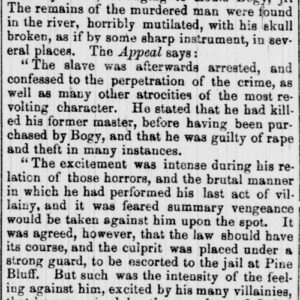calsfoundation@cals.org
Jefferson County Lynching of 1857
On July 31, 1857, an unidentified enslaved man was killed in Jefferson County for allegedly murdering a man identified only as “Dr. Guinn.” There is no information available about Guinn, except that he was “universally loved and esteemed,” but reports indicate that he was staying with Creed H. Taylor, a prominent planter near New Gascony (Jefferson County), thirteen miles west of Pine Bluff (Jefferson County). Taylor was an early settler in the county, serving as its first sheriff and first county judge. By 1860, he was one of the wealthiest cotton planters in Arkansas. The unidentified enslaved man was reportedly the property of Louis Bogy (sometimes referred to as Baggy or Boggy), another planter in the region. Bogy owned twelve slaves in 1850 and forty-three in 1860.
An early report on the incident appeared in the Memphis Daily Appeal on August 11. Citing the August 6 edition of the Pine Bluff Enterprise, the Appeal reported that a “runaway negro,” whom Guinn was either trying to capture or had already apprehended, had murdered Guinn “last week,” and that the slave was hanged by a mob “on Friday night.” The Friday night prior to August 6 was July 31. There is no further information about this reported “runaway negro” in the reports.
In the coming weeks, additional accounts of the incident appeared in several newspapers across the United States. On August 19, the Alexandria Gazette reported that Guinn’s body had been found in a river, “his skull broken, as if by some short instrument, in several places.” Quoting the Appeal (perhaps another article, since none of these details appear in the Appeal’s August 11 edition), the Alexandria Gazette reported that the unidentified man was arrested and then confessed to the killing “as well as many other atrocities of the most revolting character,” including rape, theft, and the murder of a former master. Again, there were no details given that would allow these events to be verified, such as the name of a former master; neither is the method of interrogation specified, nor are the interrogators named.
Although there was much excitement in the area, and mob violence was feared, it was decided to pursue legal avenues, and the alleged murderer was taken toward Pine Bluff under a strong guard. But, as reported, “Such was the intensity of the feeling against him…that he was seized by the mandate of Judge Lynch before reaching his jail, and hung to a tree.”
These brief accounts, as is often the case, leave many questions unanswered, such as the identity of Dr. Guinn and whether he had just been visiting the Taylors or had been living in the area; the enslaved man’s full name; and whether there was any actual evidence the man had perpetrated the murder or the prior crimes later attributed to him.
For additional information:
“Another Murder.” Memphis Daily Appeal, August 11, 1857, p. 2.
“Lynch Law in Arkansas.” Alexandria Gazette (Virginia), August 19, 1857, p. 2.
Nancy Snell Griffith
Davidson, North Carolina
 Civil Rights and Social Change
Civil Rights and Social Change Louisiana Purchase through Early Statehood, 1803 through 1860
Louisiana Purchase through Early Statehood, 1803 through 1860 Jefferson County Lynching of 1857
Jefferson County Lynching of 1857 




Comments
No comments on this entry yet.